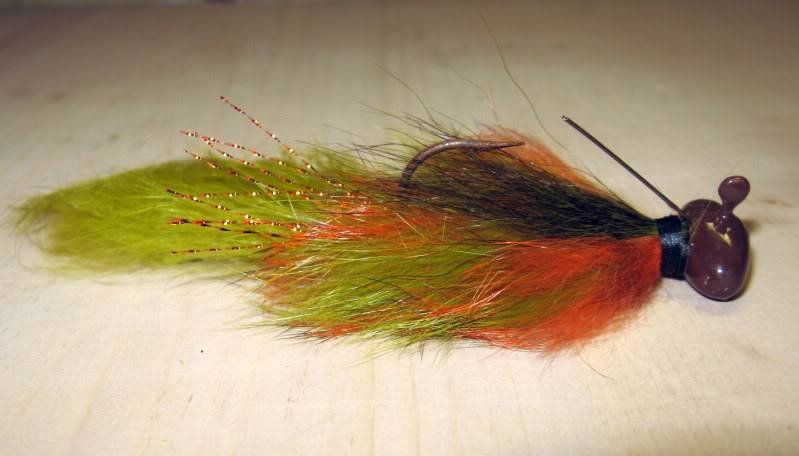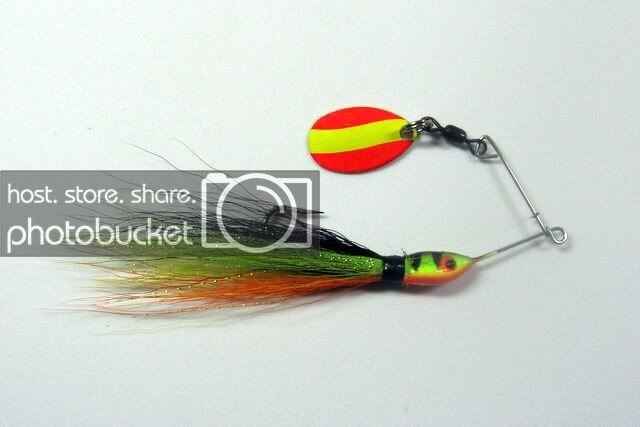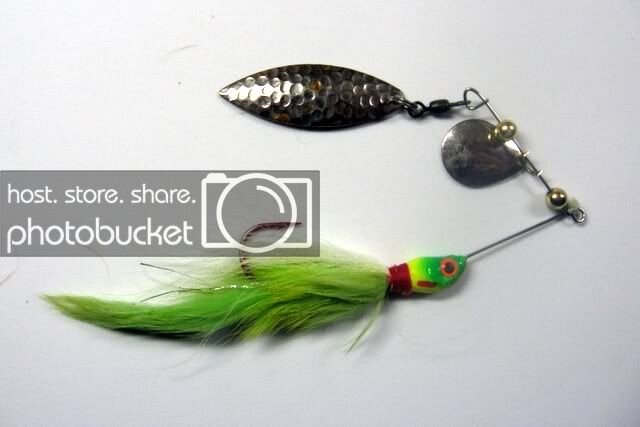-
Posts
1,047 -
Joined
-
Last visited
-
Days Won
1
Content Type
Events
Profiles
Forums
Store
Posts posted by singingdog
-
-
I have a spinning rod with micro guides and it absolutly rocks. I don't notice much difference in casting distance, but the difference in feel is dramatic. I would say that putting micro guides on a blank is almost as good as buying the next better blank with traditional guides on it.
-
Just for a different perspective, I will suggest the BPS Rick Clunn reel. I have one that has been thoroughly abused for the past 3 seasons and it still works like a charm. If you watch for the sales, you can often pick them up for less than $100. The brakes are super easy to adjust and it is built very well.
-
For many years, 2 pc rods got a bad rap because of poor ferrule construction. Because of this, many folks consider 1 pc rods to be superior because they are (pick one): more sensitive, stronger, more consistent flex.....As well, you won't find nearly as many 2 pc blanks in high-end rods.
With modern blanks, there just isn't that much functional difference between a 1 pc rod and a 2 pc rod. I recently had a custom spinning rod made, and the maker and I had long discussions about the advantages/disadvantages of 2 pc rods. His take: a 2 pc rod is just as (pick one): sensitive, strong, consistent flex....
All my rods but one are 2 pc: small car, no bass boat.
-
lol this is comedy gold...
You got that right....pretty much the entire thread. Everytime this thread pops up it is full of misconceptions and plain mistruths.
Using a RH baitcaster does not mean that you are casting with your left hand. (please repeat that until you understand it). The vast majority of folks using RH baitcasters cast with their right hand, then switch the rod to their left hand to reel with their right.
I always cast RH, but used both RH and LH baitcasters last season (it's a great way to relieve wrist stress). Unbelievably, I can switch hands and engage a lure (yes, even a bucktail) while it is still in the air. It's not that hard. I must be pretty bad with a baitcaster, because I get just as good casting performance with a LH reel as a RH reel.
Definitely some entertaining "info" in this thread.
-
Yamamoto makes some great plastic baits....their tubes are not one of them IMHO. At their prices, you can do much better for far less $.
I haven't used their insert heads, but any of their other jigheads I have used are top quality, almost always built on Owner or Gammie hooks.
-
The bad part about braids and fused lines is their knot strength. If you can get 70% knot strength....you are doing good.
If you are only getting 70% breaking strength at your knots, you need a different knot

-
The main reason to use 20 lb braid as your main line, with the leader you describe, would be knot strength. 8lb braid is very fine and will have a tendency to weaken the connector knot by cutting into your leader material. 8 lb braid has very little abrasion resistance, primarily because it is about the same diameter as 2 lb test mono/flouro line. Given the generally poor knot-strength of flouro line, the combo of 8lb braid and flouro leader would probably lead to lots of break offs.
The only advantages to going with 8lb braid would be increased casting distance and increased line capacity on your reel.
-
I agree....for bass, it's a good #s lake, but doesn't seem to produce good-sized smallies. Look at some of the connecting lakes for the brookies. They seem to move out of Kennisis and into some of the smaller lakes.
-
They will probably have better luck than BPS. Big box stores keep their prices low by dealing directly with the company, bypassing local reps and distributors. Because of that, they are good at getting a bunch of stuff cheap, but not so good at getting specific items. Any good shop will be able to make one phone call and find out what they can order, and how much it will be.
-
I have had really good luck with the PLine Hybrid in 4lb test. Great knot strength and low memory.
-
I have several of the HMX rods, which I have fished very hard and never had any problems with. I tested several - including Shimano, St Croix, and Berkley - before I bought my last Fenwick (a 7' UL). I just liked the feel of the Fenwick blank the best of any that I tried.
I have to say, of all the rods that I have looked at and fished, that Shimano Compres are the best bang for the buck: great blanks, good guides and consistent flex patterns. I have a 7' M that is a great bucktail rod.
St. Croix's are nice, but overprice IMHO
Breakage? I can never figure that out. I fish lots of days in a year, don't treat my rods particularly well, and have never had a rod break while fishing it.
-
I mostly tie jigs: bucktail, hare, silicone and some combinations. Here are a few recent ones
A slow-fall smallmouth jig: bucktail and silicone

Hare/bucktail jig

Firetiger spinnerbait: bucktail

Chartreuse spinnergait: hare/bucktail

-
What are the best snowshoes for really deep soft snow. I mean snow so soft that when you step off your snowmobile, you sink almost to your waist. We get quite a bit of snow where I live but less than the regions closer to the St-Lawrence. However, it never gets warm enough for the snow to get hard. Without snowshoes, it's trundging along in snow up to your crotch all winter. I've always liked my traditional snowshoes because the snow does not accumulate on them but the hole where the toe of the boot must pass through is too small. I have to wear huge snowmobile size 12 boots to stay warm.
Although I really like the modern shoes, it is tough to beat traditional wood/rawhide shoes for those conditions. You need a lot of float for deep, fluffy snow. An aluminum decked shoe that is going to be big enough is also going to hold a lot of snow, which can really wear on your knees if you are going any distance. The boot-size thing is just a matter of the lacing design. You may find a local repair/snowshoe maker that can alter the lacing on a pair for you.
-
I sell snowshoes, as well as use them almost every day. We carry Atlas, Tubbs, GV.
Deciding between the different companies is really about deciding which bindings you like better. I prefer the high-end Atlas bindings (11 or 12 series): they have great foot hold, don't break, and are super-easy to use. Some folks prefer the ratchet-style bindings that GV is using. I don't much like the ratchets, but that is purely a personal preference. We have some guys that beat the heck out of shoes (hydro workers, tree markers, trappers) and they all seem to prefer the GVs
Durability: I haven't noticed, over the past 10 years or so, one company being more or less durable. There is always the occasional glitch (bad run of ratchets or pop-rivets), but no "trends" that say to me that one company makes a more durable shoe than the other.
Warranty is as much about the shop as it is about the company. If the shop is willing to go to bat for you, then they will get them warrantied most of the time.
-
someone point me in the right direction. i know how to throw out a lure, and reel it in.. what is flipping? and pitching, all that bass lingo gets to me sometimes...flippin jig? FLIP!!
They are both techniques used by bass fisherman to put a lure into cover with maximum accuracy and minimum splash. They are very specialised techniques, and are quite difficult to do if you aren't standing high on the deck of a bass boat: nearly impossible sitting down. Do a Google search and be prepared to read for a couple of hours.
-
I have used that style of hook without the plastic keeper for a while. Infact the ones I use have a big barb near the eye insted. I find with these hooks u can get a hook into the roof of the mouth of a big largie much eaiser and makes them harder to loose. It has something todo with the direction of pull.
Yep, you still T-rig with hooks like that. The advantage, over the more typical offset hook is that the hook moves more easily through the plastic that you are using, resulting in a better hookset. The downside is that there is no "kink" to keep the bait in place....that's what the plastic keeper is for. If you read some of Gary Yamamotos articles from the past, he almost always uses a straight-shank hook over an offset hook for rigging worms and senkos.
IMHO, you can achieve the same results by using a light-wire offset hook.
-
-
It is really variable right now. In haliburton forest, any lake that froze after the big snowstorm has plenty of ice (they staked them with 8" about a week ago). Smaller lakes that had frozen before the storm and got snow on top of the ice only had about 1" on them.
-
The past?
-
Watch the ice thickness on the northeast side. The current that flows through to Mirror lake keeps the ice pretty thin over there.
-
Well, I guess you don't want to hear this now, but I looked at that camera and decided not to get it based on the reviews in several digital camera mags. Picture quality and lag-time were the 2 main reasons. The tap-control is a cool feature though.
-
Definitely. If you are in a tournament of that caliber - in any sport - then you come to play your hardest. You should expect the opposing team to do the same. Letting up is more insulting than running up the score.
-
I have a couple and have not been impressed with them: very little action for a jointed bait. I though they would be great musky baits, but have yet to get hit on them.
-
Some folks have been out on a small lake just down the road from me. I don't know the thickness, but I will check it today.



New Rod Company
in General Discussion
Posted
Yep. It's a custom build. Several builders in the Southeast states have been using them on spinning rods with very good luck. Mine is built on a St Croix SCIII blank. The difference in feel is dramatic.